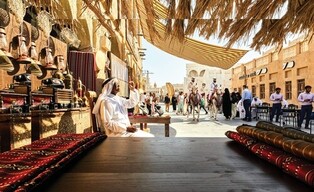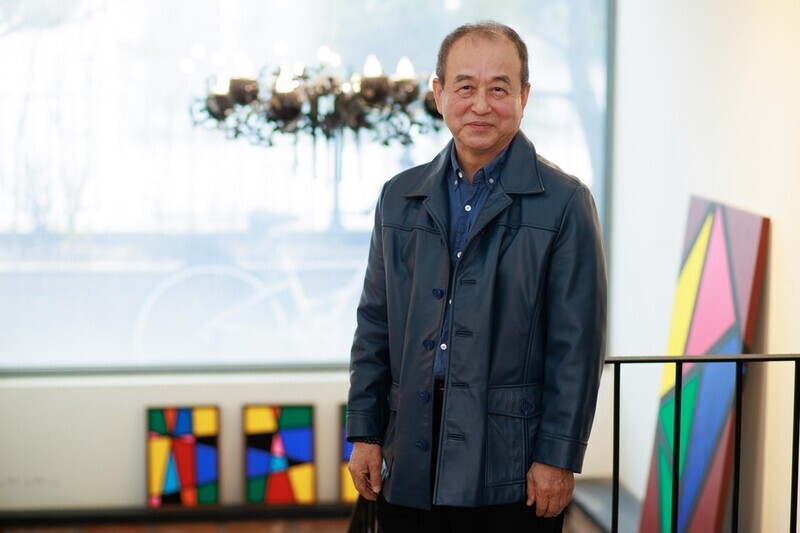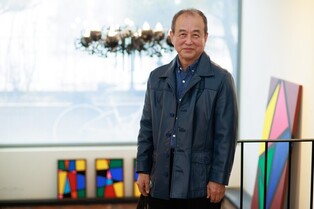Busan's Galmaetgil: 700 "Ri" of Pathways
Is walking the new DNA of modern Koreans? The walking trend shows no signs of waning, and refreshing hiking trails all over the country delight walkers. Even in the southeastern tip of the country, Busan, there are scenic walking paths. One such path is Busan's Galmaetgil, stretching 700 "ri" (about 278.8 kilometers) with 9 courses and 23 sections. Connecting coastal paths, forest paths, riverside paths, and urban paths, Busan's Galmaetgil offers its unique charm and romance. The combination of sophisticated urban culture, bustling port activity, expansive blue sea, dense forests, and the majestic Nakdong River estuary creates a colorful experience that is hard to find elsewhere but in Busan.
Galmaetgil is a portmanteau of "seagull" and "road." After the popular song "Busan Seagull" in the 1980s, seagulls became a symbol of Busan. The crying seagulls are companions of Galmaetgil walkers.
Among the notable sections of Galmaetgil are Section 2-2, which stretches from Gwangalli Beach through Igidae Coastal Walk to Oryukdo Skywalk, covering about 8 kilometers where one can enjoy a leisurely stroll soaking in the ambiance of the Nakdong River estuary, and Section 4-3, known for its beautiful sunset views at Morundae Beach, a famous migratory bird arrival site, Eulsukdo. Also, Section 6-3, nestled in the dense pine forest of Seongjigok Reservoir, is another highlight of Galmaetgil. A must-visit among these highlights is Section 3-3, which includes the Jeollyeong Coastal Walk. Together with the Igidae Trail, it represents the premium walking trails of Busan.
Galmaetgil Section 3-3 starts from Namhangdaegyo Bridge and ends at Amir Park, passing through Hyeonyul Cultural Village, Jeollyeong Coastal Walk, Jungri Beach, Yeongdo Haenyeo Culture Exhibition Hall, Gamji Coastal Walk, Taejongdae, Dongsamdongpae Exhibition Hall, and the National Maritime Museum. The total length is approximately 15 kilometers, taking about 5 hours to complete. Alternatively, one can start walking from Yeongdo Bridge, which is part of Galmaetgil Section 3-2. Yeongdo Bridge has been a landmark symbolizing the connection between Busan and Yeongdo since the Japanese colonial era. Standing on the bridge, one can overlook the summit of Bongnaesan Mountain in Yeongdo, Jagalchi Fish Market, and both the North and South Ports of Busan. Yeongdo Bridge is conveniently located near Nampo Station on Subway Line 1.
Unfortunately, access to the Gamji Coastal Walk in Galmaetgil Section 3-3 was restricted due to construction. After visiting the Yeongdo Haenyeo Culture Exhibition Hall, we took a bus to Taejongdae to conclude our journey. The latter part of Section 3-3, including the Dongsamdongpae Exhibition Hall and the National Maritime Museum, are significant venues with separate themes. It seemed better to plan a separate visit to explore them thoroughly.
Understanding Yeongdo Reveals Busan
Yeongdo is like the "Ellis Island" of Busan. Located south of Busan, Yeongdo served as a natural breakwater, enabling the development of Busan Port. With Yeongdo Bridge as the dividing point, the port to the north is called the North Port, and the one to the south is the South Port. The North Port, designated for container operations, is equipped with robust cranes, while the South Port serves as a large ship anchorage. Anchorage refers to ships dropping anchor and waiting before docking at the port. The sight of dozens of large ships anchoring on the vast sea is a unique spectacle of Busan, the maritime capital.
Yeongdo is an island with Bongnaesan Mountain at its center, forming a district that functions as a local autonomous entity. It has a population of about 160,000, larger than many cities. Its area is approximately 14 square kilometers. Yeongdo, along with Haeundae, is one of the oldest villages in Busan and where Dongam-dong Paleolithic site, a representative Neolithic site in Korea, was discovered. Yeongdo was also where sweet potatoes were first cultivated when they were brought from Japan.
The old name of Yeongdo was Jeollyeongdo. Due to its proximity to the mainland and its suitability for grazing horses, Jeollyeongdo had a horse market since ancient times, and there were many famous horses. There was even a legendary horse called "Cheonlima" that could travel a thousand "ri" in a day, so fast that its shadow could not keep up. Combining "cutting off" and "shadow" came down to the name "Jeollyeongdo," which later became "Yeongdo."
After the Imjin War, Yeongdo became virtually uninhabited again. The residents abandoned the island out of fear of Japanese invasions. On a clear day, you can see Tsushima (Daemado) from Taejongdae. The distance between Yeongdo and Tsushima is about 50 kilometers. During the Japanese colonial era, Busan and Yeongdo served as forward bases for Japan's continental expansion. During this period, industries such as pottery, modern shipyards, dyeing, and fisheries flourished in Yeongdo, and facilities such as theaters, markets, trams, fisheries testing grounds, and financial trusts were established.
Opened in 1934, Yeongdo Bridge was the first bridge in Korea to connect the mainland and an island. When the bridge was raised to let ships pass underneath, about 60,000 people gathered from all over the country to witness the opening ceremony. Considering that the population of Busan was only about 160,000 at the time, one can imagine how much attention Yeongdo Bridge drew.
During the Korean War, Yeongdo Bridge was also a significant landmark. Refugees fleeing to Busan along with the army and UN forces made a pact to meet under Yeongdo Bridge if they got separated by chance. Yeongdo Bridge was a meeting place, and the surrounding walls were filled with notes from families desperately seeking their lost loved ones. The song "Be Strong, Geumsoon," which begins with "In the stormy wind of Heungnam Port," by Hyun In (1919-2002), an Yeongdo native, expresses longing for Geumsoon, who was separated from him at Yeongdo Bridge during the 1.4 retreat. A song tile and statue of Hyun In, an Yeongdo native, are erected at the end of Yeongdo Bridge.
Even today, there are parents who tell their children they found them under Yeongdo Bridge. During the war, Busan and Yeongdo were crowded with refugees, and many abandoned children were found under Yeongdo Bridge. Before the war, Busan's population was not even 200,000, but when the war broke out, the population in the Jung-gu area around Busan Port alone exceeded 5 million.
White Rapids and the Sound of Breath
Hyeonyul Cultural Village, a popular spot in Galmaetgil Section 3-3, was also a village formed by refugees during the Korean War. The water flowing down from the Bongnaesan Mountain above the village is as white as snow, hence the name "White Rapids." Now, it is one of the most visited places after Gwangalli Beach and Haeundae, with quaint cafes and shops. The village is traversed by Jeollyeong Road, one of the most scenic roads in Korea, and below lies Jeollyeong Coastal Walk, a premium walking trail. These paths allow you to observe the coastal landscape formed by rocky cliffs up close and fill your eyes and heart with the blue sky and sea. Many movies such as "The Attorney," "The War of Prosecutors," "Typhoon," and "Countdown" were filmed in the village. "The Attorney," which attracted tens of millions of viewers, tells the story of Song Woo-seok (played by Song Kang-ho), a lawyer who became a human rights lawyer after defending a university student from a poor village in Hyeonyul who was falsely accused of espionage and subjected to assault and torture.
In Galmaetgil Section 3-3, you'll experience ups and downs between Jeollyeong Road and Jeollyeong Coastal Walk. Along Jeollyeong Road, you'll find the Sky Observatory, where you can observe Daemado on a clear day, and the 75 Square, built in 1975, which offers panoramic views and rest areas.
At the Yeongdo Haenyeo Culture Exhibition Hall on Jungri Beach, you can learn about the history of Yeongdo's female divers. The first floor of the exhibition hall is a market where the Haenyeo directly sell seafood they catch. The origin of Yeongdo Haenyeo is Jeju Haenyeo. In the 1890s, Jeju Haenyeo ventured out of Jeju Island for the first time and began working in Yeongdo. Yeongdo was the first stop for Haenyeo who ventured beyond Korea and explored the waters of Northeast Asia, opening a new chapter in the history of Jeju Haenyeo. In 2019, Jeju Special Self-Governing Province donated the Jeju Haenyeo Award to the exhibition hall to honor the spirit and courage of Jeju Haenyeo, who have been working in Yeongdo for over 100 years.
When Haenyeo dive deep into the sea to harvest seafood and their breath reaches their necks, they exhale with a whistling sound when they emerge from the water. This exhalation is called "sumbisori" (the sound of breath). The writings inside the exhibition hall, such as "The sea is my life" and "If you don't keep away from greed, the sea will take away your breath," are profound.
In the Galmaetgil 3-3 section, you'll find yourself navigating between Jeollyeong Road and Jeollyeong Coastal Walking Trail. Jeollyeong Road offers a clear sky observation deck where you can observe Daemado on clear days, as well as the 75 Plaza built in 1975, which provides expansive views and resting areas.
At Jungri Beach, you can explore the history of Yeongdo's haenyeo (female divers) at the Yeongdo Haenyeo Cultural Exhibition Hall. The first floor of the exhibition hall is a seafood market where haenyeo directly sell the seafood they catch. The origin of Yeongdo's haenyeo dates back to Jeju haenyeo. In the 1890s, Jeju haenyeo ventured outside Jeju Island for the first time to start harvesting marine resources in Yeongdo. Yeongdo served as the first destination for emigrating haenyeo, opening a new chapter in the history of Jeju haenyeo. To honor the spirit and resilience of Jeju haenyeo, which has continued for over 100 years in Yeongdo, Jeju Special Self-Governing Province donated a Jeju Haenyeo statue to the exhibition hall in 2019.
When haenyeo dive deep into the sea to harvest seafood, they emit a whistling sound as they come out of the water with their breath almost running out. The inscription inside the exhibition hall, "The sea is my life" and "If you don't give in to greed, you'll live even if you eat water," is solemn.
The Taejongdae area revitalizes Yeongdo's illustrious history. There are two theories about the origin of the name Taejongdae. One is that it originated from King Taejong Muyeol of Silla, who enjoyed shooting arrows while intoxicated by the scenery here. Another story is that in 1419, during a severe drought in Joseon, King Taejong visited here and prayed for rain, which subsequently fell. Taejongdae boasts a picturesque landscape formed by lush forests and coastal erosion cliffs harmonizing with the blue sea. It is designated as a national geological park. In the 1960s and 1970s, when tourism resources were not yet fully developed, Taejongdae was a highly esteemed, pristine tourist destination, often regarded as the top honeymoon spot.
Taejongdae also bears the pain of the Northern Yeongdo Guerrilla Corps. The Yeongdo Guerrilla Corps was an irregular unit established in late 1950. Composed of about 1,200 voluntary recruits who escaped from North Korea's Hamgyeongnam and Hamgyeongbuk provinces and northern Gangwon Province during the 1.4 Retreat, they were trained at Taejongdae. Among them, about 900 infiltrated North Korea to carry out missions such as blowing up railways and disrupting rear operations. However, due to the sudden ceasefire, only 33 survived out of the 900 members. It is known that most of the members enlisted with the determination to somehow bring down their families left behind in North Korea.
"A memorial inscription placed beside the walking trail reads: 'The young members of the Republic, who left without a military number or rank, leaving under the resolve of not expecting a single penny or reward, under the pine trees and rocks of Taejongdae on the day they left, cutting their hair and nails, infiltrating the enemy's rear by land and sea.'"
(The article was translated into English by artificial intelligence.)
(C) Yonhap News Agency. All Rights Reserved

























![[가요소식] 보이넥스트도어, 신보로 3연속 밀리언셀러 달성](/news/data/20251025/yna1065624915905018_166_h2.jpg)








